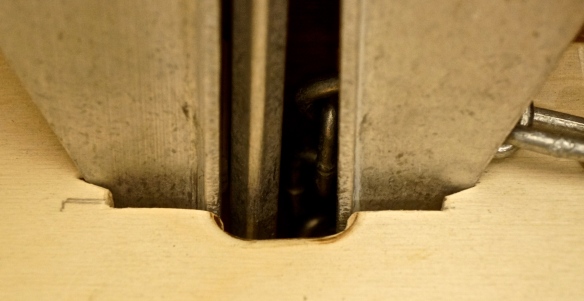There long, ungainly and important. But, how to store them? This seems to be the vexing problem, especially if you want oars over 8′ long. And, if you settle for 8′ oars they will be a little too short.
Well, you’ve seen my 9′ break down oars. Now, let’s store them.
 Starboard side: The water gutter provides a nice little dip for the blade section to rest into. They also fit nicely along side the filler boards.
Starboard side: The water gutter provides a nice little dip for the blade section to rest into. They also fit nicely along side the filler boards. Port side:
Port side:
 And, I can still move the filler boards forward with the oars stowed away. A little tight, but it works.
And, I can still move the filler boards forward with the oars stowed away. A little tight, but it works.
 I wanted a system that held the oars securely even if the boards were removed. Meet the basic bungie cord. Both ends are knotted inside the wet storage locker. This keeps the system trim. I drilled 4 holes into the wet storage area (2 for the blade & 2 for the handle). There is a knot between the blade loop and handle loop (also located inside the wet storage area) to keep the handle loop from drawing tight.
I wanted a system that held the oars securely even if the boards were removed. Meet the basic bungie cord. Both ends are knotted inside the wet storage locker. This keeps the system trim. I drilled 4 holes into the wet storage area (2 for the blade & 2 for the handle). There is a knot between the blade loop and handle loop (also located inside the wet storage area) to keep the handle loop from drawing tight.
 This shows the Port side and the proximity to the anchor arm.
This shows the Port side and the proximity to the anchor arm.
 Starboard side Upfront: I moved the CB uphaul line up higher on the seat longitudinal. It provided just enough room for the oars to run underneath them. The bungie keep things from shifting inboard and provides a nice spot to tend the CB uphaul line. The water gutter again provides a nice notch for the bottom oar to rest.
Starboard side Upfront: I moved the CB uphaul line up higher on the seat longitudinal. It provided just enough room for the oars to run underneath them. The bungie keep things from shifting inboard and provides a nice spot to tend the CB uphaul line. The water gutter again provides a nice notch for the bottom oar to rest.
 Port side Upfront: When you want to retrieve the oars, you simply pull the bungie forward and slide the two stick forward and out.
Port side Upfront: When you want to retrieve the oars, you simply pull the bungie forward and slide the two stick forward and out.
 The knots are tied under the seat extension and inside the footwell. This keeps it simple and clean.
The knots are tied under the seat extension and inside the footwell. This keeps it simple and clean.
I’m happy with this basic system. Now moving my attention to fender stowage. I do not want these things inside my boat.



























































